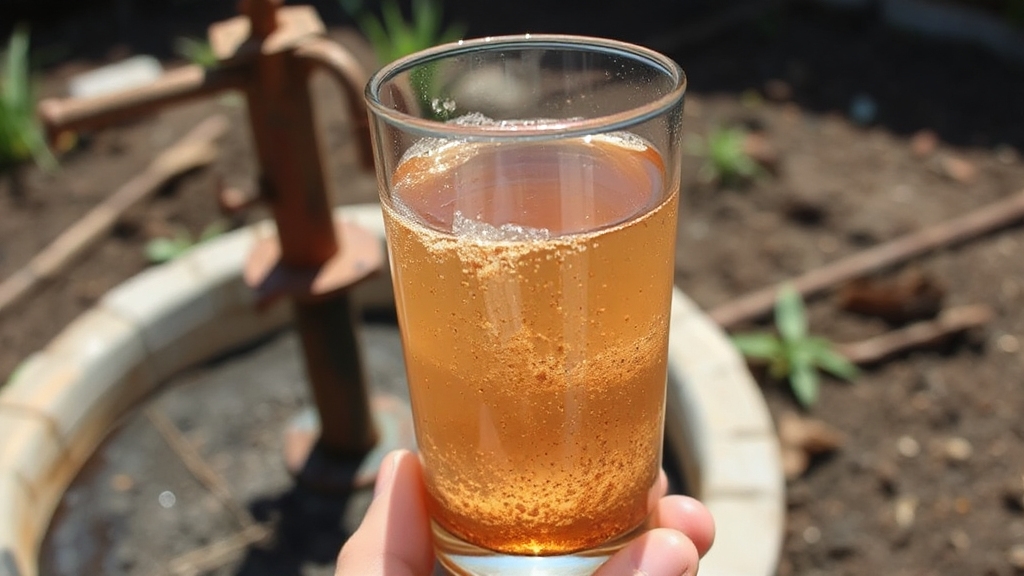Last Updated on June 22, 2025
Your well water likely turns brown due to iron particles, sediment, or rust from corroded pipes and aging equipment. Iron naturally dissolves into groundwater, and environmental factors like heavy rain can introduce organic debris and soil into your well.
Iron bacteria may also cause reddish-brown slime that discolors water and clogs plumbing. Identifying the specific cause is key for effective treatment and maintenance. Understanding these factors can help you restore and maintain clear water quality.
Key Takeaways
- Brown well water often results from rust due to corroded pipes, pumps, or hot water tanks releasing iron particles.
- Surface runoff after heavy rain can carry sediment, organic matter, and tannins into poorly sealed or damaged wells.
- Natural iron and iron bacteria in groundwater oxidize and precipitate, causing reddish-brown discoloration and slimy deposits.
- Plumbing disturbances or aging infrastructure can dislodge rust and sediment, temporarily turning water brown.
- Regular testing and well maintenance are essential to identify causes and prevent ongoing brown water issues.
Common Causes of Brown Well Water
Although brown well water can result from various factors, it most commonly arises due to mechanical failures within your water system. Corrosion in rusty hot water tanks and pipes releases rust particles that discolor water. This contamination can pose serious health risks if consumed without proper treatment.
Aging or malfunctioning well pumps often introduce sediment or rust, further contributing to the issue. Additionally, corrosion in plumbing fittings or connections can contaminate your water supply, causing a brown tint.
Overall deterioration of water distribution infrastructure exacerbates these effects by increasing the likelihood of rust and sediment entering your water. Sometimes, iron or manganese naturally present in the water supply can also cause brown discoloration.
Role of Iron in Water Discoloration
You’ll find iron underground in various forms that easily enter your well water, often influenced by natural deposits and environmental conditions. Iron commonly exists in the ferrous and ferric oxidation states, which affect its solubility and presence in water.
Iron bacteria can exacerbate discoloration by producing slime and accelerating iron oxidation, complicating water quality. To address these issues, you’ll need targeted removal methods like specialized filtration or oxidation treatments designed to handle both dissolved and bacterial iron.
Understanding the wattage requirements of devices used in water treatment can help ensure proper operation during power outages.
Iron Sources Underground
Where does the iron that discolors well water actually come from? Primarily, it originates from underground geological formations containing iron-bearing minerals like goethite, limonite, and glauconite.
As groundwater flows through aquifers composed of iron-rich sediments, it dissolves iron through weathering and geochemical reactions. The redox potential (Eh) and pH influence iron’s chemical form—ferrous (dissolved) or ferric (oxidized)—affecting its solubility and coloration.
Iron levels greater than 10 mg/L are uncommon in drinking water but even minimal iron intake (around 0.3 mg/L) can cause water discoloration secondary contaminant. Improper well system components, such as a faulty pressure regulator, can also indirectly affect water quality by altering flow dynamics.
Rainwater infiltration and human activities like mining can accelerate iron release into groundwater. These processes result in elevated iron concentrations, often exceeding the secondary maximum contaminant level of 0.3 mg/L, leading to the characteristic brown discoloration in well water.
Iron Bacteria Effects
Iron in well water doesn’t just come from geological sources; it also interacts with microorganisms known as iron bacteria that influence water discoloration.
These bacteria consume dissolved iron, oxidizing ferrous iron into ferric iron, which precipitates as insoluble iron oxides. Proper valve sizing in plumbing systems connected to well water can help manage flow and reduce buildup issues.
This biological process accelerates iron precipitation, causing reddish-brown slime deposits that discolor water and coat pipes, wells, and fixtures. You’ll notice rusty water, slime buildup, and sometimes an unpleasant odor or metallic taste.
Although iron bacteria are not known to cause disease, they can create conditions conducive to growth of other pathogens. Iron bacteria slime can clog plumbing and promote corrosion, reducing system efficiency and complicating maintenance.
Iron Removal Methods
Although the presence of iron in well water often leads to brown discoloration, effectively removing it requires understanding its chemical forms and sources.
Iron exists mainly as ferrous (colorless) and ferric (colored), with ferric iron causing the brown tint. Proper water testing is critical to determine iron type and concentration before choosing a system.
To tackle this, oxidation filtration is your best option. This method converts ferrous iron into ferric iron, which can then be filtered out. You’ll encounter oxidants like hydrogen peroxide, chlorine, and potassium permanganate, each varying in effectiveness and maintenance needs.
Choosing the appropriate oxidant should consider water system efficiency to ensure optimal performance. Hydrogen peroxide stands out for moderate iron levels due to minimal upkeep and no sludge production.
Selecting the right system depends on your water’s iron concentration, cost, and maintenance capacity. Proper removal improves water clarity, reduces staining, and protects plumbing, ultimately enhancing your well water’s quality and usability.
How Plumbing Issues Affect Water Color?
When your well water turns brown, plumbing issues often play a significant role by introducing rust, sediment, and other contaminants into the supply.
Corroded iron or steel pipes release rust particles, coloring the water orange to brown throughout your whole house. Use the correct wire gauge and equipment when working with pumps to avoid further complications.
Sediment buildup in your water heater can discolor hot water specifically. Additionally, worn faucets or valves may cause initial discoloration that clears after running water briefly.
Changes in water pressure or recent plumbing work can disturb settled rust and sediment, temporarily affecting water clarity. Note that rusty water is not dangerous but can stain sinks, laundry, and food.
- Corroded iron or steel pipes release rust and sediment
- Water heater rust causes brown discoloration in hot water only
- Faucet corrosion leads to brown water on first draw
- Pressure changes dislodge sediment causing temporary brown water
- Older plumbing materials increase risk of discoloration
Environmental Factors Contributing to Brown Water
You’ll notice that surface water runoff often carries sediments and organic materials into your well, directly impacting water color. Decaying plant material, such as leaves and roots, releases tannins and other compounds that cause discoloration.
Additionally, rainwater and snowmelt can carry contaminants and microorganisms into wells, mixing with underground aquifers or directly entering well systems, which can further affect water quality and appearance due to contamination sources.
Understanding these factors helps you identify sources of brown water and address them effectively. Regular cleaning and filtration can mitigate sediment impact and help maintain pump longevity.
Surface Water Runoff
Because increased precipitation boosts surface runoff, your well water can quickly become discolored when natural soil filtration is overwhelmed. Heavy rains carry sediment, iron, and other contaminants from surrounding land directly into your well, especially if the casing is cracked or shallow.
In some cases, the presence of corrosion-prone materials in well components can exacerbate discoloration issues. Saturated ground can’t effectively filter out fine particles like silt or sand, leading to brown or turbid water. Wells near slopes, floodplains, or disturbed land are particularly at risk.
Conduct professional water testing to identify specific contaminants causing discoloration. Monitoring runoff sources and well integrity is essential to prevent contamination.
- Surface runoff increases sediment and pollutant load
- Saturated soils reduce natural filtration capacity
- Wells near flood-prone or agricultural areas face higher risks
- Iron and organic material mobilize in runoff, causing discoloration
- Proper well sealing and land management mitigate intrusion
Decaying Plant Material
Although decaying plant material may seem harmless, it considerably impacts well water quality by introducing organic debris such as leaves and soil matter into the system. This debris often enters wells after heavy rains, especially if the well casing is poorly sealed or damaged.
As the plant material decomposes, it releases tannins—water-soluble compounds that discolor water with a brown or tea-like hue. While tannins don’t usually pose health risks, they stain fixtures and complicate treatment. In some cases, chlorine shock treatment can help reduce organic bacterial growth that worsens discoloration.
Additionally, organic decay can produce musty odors and promote bacterial growth, which further degrades water quality and may clog well components. Such blockages can create mechanical issues that affect water flow and pressure.
Environmental factors like rainfall, vegetation density, and soil disturbances influence the extent of organic infiltration. To mitigate these effects, maintain well integrity, inspect regularly, and consider filtration systems targeting tannins and organic compounds.
Identifying Iron Bacteria and Other Contaminants
How can you accurately identify the causes of brown discoloration in your well water? Begin by examining visible clues such as rusty slime or stains on fixtures, which indicate iron bacteria. You might also detect a foul or petroleum-like odor or notice an oily sheen on the water’s surface.
These microorganisms naturally found in soil and water form rust deposits, contributing to slime buildup that signals their presence. Testing your water in a laboratory is essential to confirm the presence of iron bacteria or other contaminants like manganese, sediment, or organic matter.
Regular water quality tests and well inspections can help detect corrosion or biofilm buildup that may contribute to discoloration. It is important to monitor water quality regularly to ensure timely detection of contaminants.
- Rusty, slimy deposits in pipes and toilets
- Yellow, orange, or brown stains on fixtures
- Foul, swampy, or petroleum-like odors
- Laboratory confirmation of iron bacteria
- Signs of corrosion or sediment contamination
Effective Treatment Options for Discolored Well Water
After identifying the contaminants causing brown discoloration in your well water, the next step is selecting appropriate treatment methods to restore water quality.
You’ll want to look into filtration systems, chemical treatments, and specialized methods depending on the contaminant type. Regular maintenance ensures lasting effectiveness.
Additionally, regular testing at EPA-certified facilities is recommended at least once annually to monitor contaminant levels and water safety. Here’s a concise overview:
| Treatment Type | Purpose |
|---|---|
| Reverse Osmosis | Removes dissolved solids |
| Sediment Filters | Captures particulate matter |
| Shock Chlorination | Eliminates bacteria in wells |
| Iron/Manganese Filters | Targets metal contaminants |
| Activated Carbon | Removes taste and odor issues |
Choosing the right combination tailored to your water’s specific contaminants maximizes results. Professional assessment may be necessary to optimize treatment strategy and make sure safe, clear water.
Preventive Steps to Maintain Clear Well Water
When you prioritize regular inspections and proper maintenance, you markedly reduce the risk of well water discoloration and contamination. Proactive measures focus on preserving system integrity and preventing external pollutants from entering your well.
Maintaining a clear well environment involves controlling debris and ensuring proper site management, while routine mechanical upkeep minimizes sediment disturbances. It is also crucial to seal the annular space between the casing and borehole with grout to prevent surface contaminants from entering the well.
Key preventive steps include:
- Schedule annual professional inspections covering wellhead, pumps, and pipes.
- Maintain a 100-foot clear zone free of chemicals and organic debris.
- Ensure proper grading around the wellhead to divert surface water.
- Use certified professionals for any construction or repairs.
- Regularly clean and service pumps to reduce sediment agitation.
Implementing these steps systematically safeguards water clarity and promotes long-term well functionality.
Importance of Regular Testing and Maintenance
Although well water may appear clear and fresh, regular testing and maintenance remain essential to guarantee its safety and quality. The EPA recommends testing your well water annually, preferably in spring, to assess bacteria, nitrates, and total dissolved solids in EPA-certified labs.
You should test more frequently if anyone in your household is pregnant, if your well is shallow, or after flooding or nearby industrial activity. Testing after such events helps identify potential contamination early, which is crucial for water safety.
Regular maintenance extends your well’s lifespan, typically 30 to 50 years, and post-repair testing ensures safety. Use cost-effective kits covering essential parameters, but rely on certified labs for accuracy. Adhering to legal guidelines and contamination standards protects your household.
Frequently Asked Questions
Can Brown Well Water Be Harmful to Pets or Livestock?
Yes, brown well water can harm your pets and livestock. It often contains bacteria, parasites, and minerals like iron and manganese, which may cause digestive issues, infections, or organ damage.
Toxic algae and chemical contaminants can also pose severe risks, including neurological symptoms or kidney failure. To protect your animals, regularly test your water and consider providing filtered or bottled water, especially if you notice health problems or unusual behavior after drinking from the source.
How Quickly Should I Respond to Sudden Brown Water in My Well?
You should respond to sudden brown water in your well within 24 to 48 hours to minimize health risks and prevent damage to plumbing or appliances. Avoid using the water for drinking, cooking, or bathing until you identify the cause and test for contaminants.
Contact a certified well professional promptly to inspect and remediate the issue. Using alternative water sources immediately helps guarantee safety while you address the problem.
Are There Natural Remedies to Reduce Brown Discoloration in Well Water?
You’ll find that about 60% of well water discoloration cases respond somewhat to natural remedies. Boiling kills bacteria but won’t remove minerals or sediment. Letting water sit lets particles settle, improving clarity.
Plants like cattails absorb contaminants, while sunlight disinfects bacteria but not minerals. Zeolites can also absorb some minerals. These methods help reduce brown discoloration but often require combining with filtration for effective, lasting results.
Does Brown Water Affect the Taste or Odor of My Drinking Water?
Yes, brown water often affects the taste and odor of your drinking water. Contaminants like iron bacteria can cause metallic or swampy flavors and unpleasant odors. Organic matter may introduce earthy tastes and smells.
While hydrogen sulfide produces a rotten egg odor, it usually doesn’t cause discoloration. To accurately identify and address these issues, you should test your water and consider filtration or professional treatment to improve taste and odor effectively.
Can Seasonal Changes Permanently Damage My Well System?
Seasonal shifts act like nature’s sculptor, gradually shaping your well system’s fate. You risk corrosive water eroding pipes and mineral buildup clogging pumps as dry spells concentrate sediments.
Repeated water table fluctuations strain casings, potentially cracking seals. Without vigilant maintenance, these subtle forces can cause permanent damage.
From Brown to Brilliant: Restoring Your Well Water’s Quality
Think of your well water as a mirror reflecting the health of your home’s plumbing and environment. Brown discoloration often signals iron presence, bacteria, or plumbing wear. By regularly testing and addressing these issues, you’re not just clearing water but restoring clarity and safety.
Taking preventive steps guarantees your water remains a transparent source of life, not a warning sign. Stay proactive to keep your well water’s true nature shining through.



